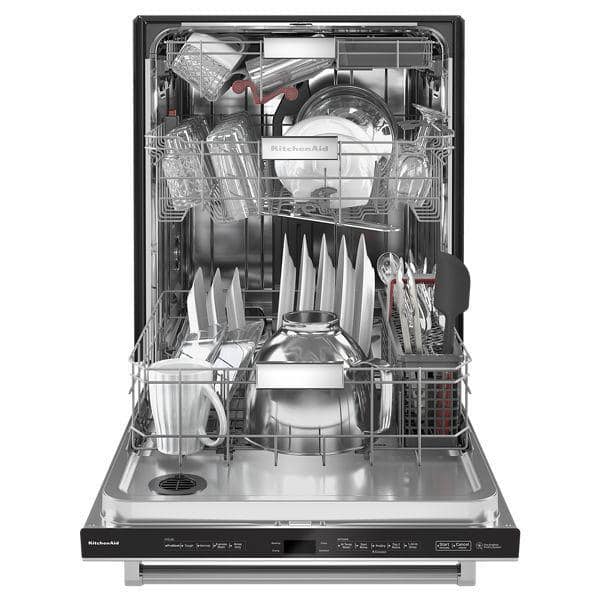Bosch 300 Series 24 in. Stainless Steel Front Control Tall Tub Dishwasher with Stainless Steel Tub and 3rd Rack, 44dBA
44 dBA: Quietest Dishwasher Brand in the U.S. A 3rd Rack and adjustable upper rack for loading flexibility. FlexSpace Tines fold back to fit your larger pots & pans.
From their legendary quiet performance to their promise of sparkling clean dishes, Bosch dishwashers deliver a lasting quality you’ve come to trust and expect. Premium materials, combined with exceptional workmanship, provide the kind of fit and finish you expect from a Bosch Dishwasher. Discover how Bosch dishwashers are flexible enough to handle whatever life brings.
- 3 Prong Power Chord Included. Junction box for hardwire application sold separately (Model # SMZPCJB1UC)
- Sanitize Option reduces 99.9% of bacteria with a hot-wash rinse for sparkling clean and sanitized dishes
- Sanitize your dishes: The Sanitize feature is available only in the Heavy, Auto, Normal and Half Load cycles. Select one of these cycles, press the “Sanitize Option” button and then press Start to activate the Sanitation features. The sanitize LED will light when sanitation requirements are met. The sanitation option eliminates bacteria and may enhances drying results
- Front controls offer easy cycle and option selection
- Quiet 44 dBA sound level so your kitchen conversations aren’t interrupted
- Holds 16 place settings to accommodate your loading needs for different occasions
- Offers 5 wash cycles, including heavy, auto, normal, rinse and hold, Speed60 (1 hour wash) and 4 options including delay start, half load, sanitize and extra dry
- ENERGY STAR qualified for year-round energy savings
- Engineered for a lifetime of use, the premium stainless steel tub provides a solid foundation for our exceptional dishwashers
- Whether its gel, powder or tabs, the detergent tray’s flexible design optimizes the cleaning process; helping you achieve perfectly clean dishes with every cycle
- 3rd rack adds versatility and offers 30% more loading capacity
- RackMatic offers 3 height levels, for 9 possible rack positions
- FlexSpace tines fold back to fit your larger pots and pans
- Spray arms project water directly toward your dishes, they minimize spraying the inner sides and door, further reducing noise
- Half load option reduces cycle time and water consumption when washing small, lightly soiled loads that fill half or less of the dishwasher’s capacity
Additional information
| Cut-Out Depth x Height x Width (in.) | 24 x 33.88 x 23.56 |
|---|---|
| Depth - Door Shut (with Handle) (in.) | 23.75 |
| Depth - Door Shut (without Handle) (in.) | 23.75 |
| Depth With Door Open 90 Degrees (In) | 48.44 |
| Dishwasher Size (In.) | 24 |
| Height - Maximum (in) | 35 |
| Height - Minimum (in) | 33.88 |
| Product Depth x Height x Width (in.) | 23.75 x 33.88 x 23.56 |
| Certifications and Listings | CSA Listed,Energy Star,NSF Certified,UL Listed |
| Manufacturer Warranty | 1 Year Limited |






by Rick
I’ve only had it 3 weeks. I only use the Auto function. It cleans really well in about 2 hours. Plastic items are a little wet but I don’t mind that. A little shake and I put them away. I adore the top silverware rack. No crowding makes every piece clean. I elected to use the Home Depot installation service and that was well worth it.
by Christina
Soooo quiet and cleans good too! Love my new dishwasher.
by Matt
I LOVE my new Bosch. We have had it for about a month. The glasses are spotless without an extra rinse. The top silverware tray is very convenient and easy to use. The silverware is shinier than I have ever seen it. We took out the upright silverware bin, and that gives us extra room for dishes. The dishwasher is not as quiet as our old one was, but it is quiet enough. We installed the dishwasher ourselves. Having controls and display on front is very convenient, better than hidden on the top like on the previous unit. Did not like the plastic (nylon) water fitting on the back of the unit — it uses a garden hose type connector which is inappropriate for a permanent water connection. Almost mis-threaded when putting on metal hose supply fitting. (Would be much better if it had a standard metal plumbing fitting and an accessible filter in the front.)
by Traig
FANTASTIC dishwasher. We are bakers and use it several times per day. It’s perfect!
by Jerry
It does an excellent job of washing the dishes. A bonus is that it is very quiet.
by Bob
After having nothing but trouble with “cheap dishwashers” we finally decided to buy a premium one. Bosch was highly recommended by two friends who have had theirs for many years. Very simple install. Simple to use. Really clean dishes. Incredibly quiet. Perfect so far.
by Guy
Great dishwasher nice and quiet does a great job and cleaning.
by Dee
Absolutely love this dishwasher!!! So quiet and works excellently. No spots, dries everything, cleans so good!! Highly recommended!
by Ian
Love our new Bosch! It replaced an older Bosch that died when the main pump gave out. So: take care of your Bosch or you will need to replace it in 6 years when the $400 pump gives out.